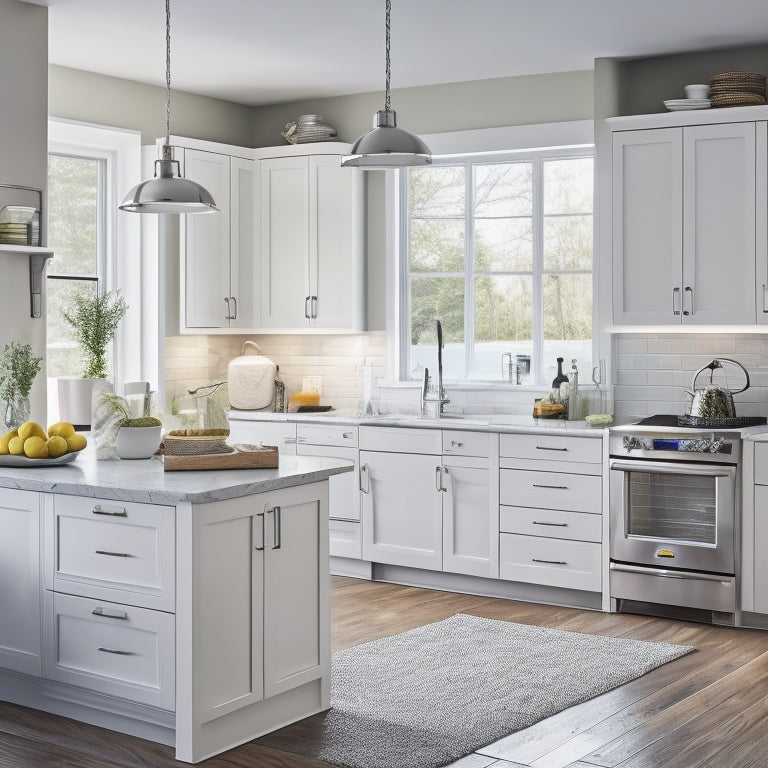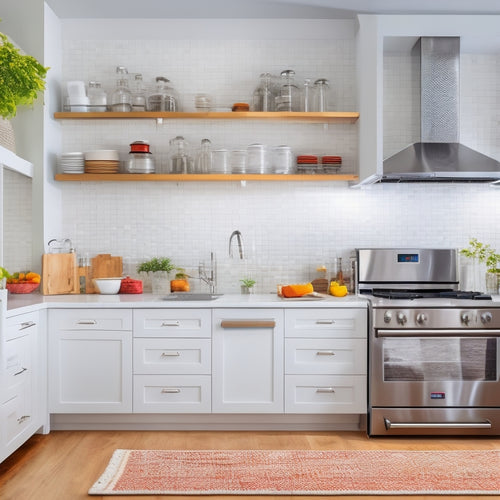
Ultimate Guide to Top-Notch Kitchen Storage Solutions
Share
You're just a few steps away from transforming your kitchen into a streamlined, efficient space that prioritizes food safety and boosts productivity. By investing in high-quality kitchen storage solutions, you'll minimize contamination risks, reduce food waste, and increase your bottom line. Commercial-grade storage containers with snap-tight covers, easy-to-read labels, and temperature versatility are must-haves for any kitchen. With the right storage essentials, you'll be able to optimize your kitchen space, implement efficiency strategies, and take your kitchen operations to the next level. Get ready to uncover the secrets to a safer, more efficient kitchen.
Key Takeaways
• Invest in high-quality, commercial-grade storage solutions to maintain food safety, quality, and efficiency in your kitchen.
• Prioritize containers with snap-tight covers, easy-to-read labels, and durability for optimal storage and transport.
• Implement efficient organization tips, such as categorizing and dating stored items, to streamline kitchen operations and minimize contamination risks.
• Choose storage products with temperature versatility, suitable for coolers or freezers, and made from food-grade materials for long-term cost savings.
• Optimize kitchen space with cost-effective shelving units and maximize storage capacity to boost productivity and customer satisfaction.
Importance of Kitchen Storage
When it comes to maintaining a clean, efficient, and safe kitchen, you can't afford to overlook the critical role that proper storage solutions play in guaranteeing the quality and freshness of your ingredients and prepared dishes.
Using domestic tools in commercial kitchens can compromise food safety, leading to health inspection issues and increased food wastage. To avoid these risks, it's vital to invest in high-quality storage containers with appropriate lids and labeling. This not only helps maintain food freshness but also guarantees food safety.
By implementing effective organization tips, such as categorizing and dating stored items, you can streamline your kitchen operations and minimize the risk of contamination.
Prioritize food safety and efficiency by choosing the right storage solutions for your kitchen.
Benefits of Commercial Solutions
By investing in commercial storage solutions, you'll not only guarantee food safety and quality but also reap significant financial benefits, including reduced food, delivery, and labor costs. These cost saving solutions are designed with durability in mind, ensuring you get the most out of your investment.
With commercial storage, you can trust that your food will meet the highest food safety standards, minimizing the risk of contamination and waste. Plus, products like Cambros offer temperature versatility, suitable for use in coolers or freezers, and are made from food-grade materials.
Quality Storage Product Features
Opting for high-quality storage products like Cambros guarantees that you're getting containers with features that truly matter, such as snap-tight covers that minimize the risk of cross-contamination and easy-to-read labels that simplify inventory management.
You'll appreciate the container durability, which can withstand extreme temperatures from 99°C to -40°C, ensuring your food stays safe and fresh. The snap-tight covers are designed to remain secure during transport, preventing spills and messes.
With easy identification, you can quickly locate the contents, saving you time and reducing errors. By investing in these quality storage products, you're investing in the longevity and safety of your kitchen operations.
Commercial Storage Essentials Checklist
To guarantee your kitchen is equipped with the right storage solutions, you'll want to prioritize the following commercial storage essentials.
First and foremost, invest in containers that boast exceptional durability, such as Cambros polycarbonate containers, which are virtually indestructible and long-lasting. Make sure your storage organization is on point by opting for containers with snap-tight covers that minimize the risk of cross-contamination. Additionally, choose containers that are easy to identify contents and remain secure during transport.
Investing in Kitchen Efficiency
Streamlining your kitchen operations with efficient storage solutions can greatly reduce labor costs and boost productivity, allowing you to focus on perfecting your culinary craft.
By implementing efficiency strategies and optimizing your kitchen space, you'll be able to work smarter, not harder.
Invest in cost-effective solutions that maximize your storage capacity, like high-quality containers and shelving units. This will enable you to quickly locate ingredients and supplies, saving you time and energy.
With a more organized kitchen, you'll experience a significant productivity boost, allowing you to tackle more orders and deliver exceptional results.
Frequently Asked Questions
Can I Use Plastic Containers With Metal Lids in the Microwave?
You shouldn't use plastic containers with metal lids in the microwave, as metal can spark or even cause a fire when heated, compromising plastic container safety and risking your kitchen's well-being.
How Often Should I Replace My Kitchen Storage Containers?
You should replace your kitchen storage containers every 3-5 years, depending on usage and material compatibility, as worn-out containers can compromise food safety, and incompatible materials can lead to contamination or degradation.
Are Glass Storage Containers Better Than Polycarbonate Ones?
You're weighing glass vs polycarbonate storage containers, considering durability, safety, and eco-friendliness. While glass is more sustainable, polycarbonate containers like Cambros are more durable, shatter-resistant, and cost-efficient, making them a better choice for high-traffic kitchens.
Can I Store Raw Meat and Vegetables in the Same Container?
You shouldn't store raw meat and veggies in the same container, as it risks cross-contamination and compromises food safety; instead, prioritize storage organization and food rotation to guarantee separate, covered containers for each.
Do I Need to Label Containers Stored in a Dry Storage Area?
You're probably thinking a dry storage area is a free-for-all, but think again - labeling containers is important even here, as it maintains your organizing system and guarantees you can quickly locate what you need, reducing chaos and increasing control.
Related Posts
-

Optimize Your Kitchen Storage With 7 Simple Hacks
You're already wasting valuable kitchen space without realizing it, and it's likely due to a lack of strategic storag...
